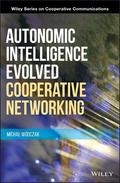Autonomic Intelligence Evolved Cooperative Networking
Wiley Series on Cooperative Communications

1. Edition April 2018
288 Pages, Hardcover
Wiley & Sons Ltd
Autonomic Intelligence Evolved Cooperative Networking offers a comprehensive advancement of the state-of-the art technological developments in the fields of Cooperative Networking and Autonomic Computing. Based on his track record in industrial standardisation, as well as academic and applied research, the author presents a fully-fledged Autonomic Cooperative Networking Architectural Model that encompasses the relevant workings of both the Layers of the Open Systems Interconnection Reference Model and the Levels of the Generic Autonomic Network Architecture.
Preface xi
Acknowledgements xiii
Acronyms xv
Notation xxiii
1 Introduction 1
2 Autonomically Driven Cooperative Design 7
2.1 Introduction 7
2.2 Biologically Inspired Autonomics 8
2.2.1 Rationale and Vision 8
2.2.2 Nomenclature 12
2.2.3 Towards Self-Management 16
2.3 Emergent Autonomic Networking 20
2.3.1 Generic Autonomic Network Architecture 20
2.3.2 Decision-Making Entities 24
2.3.3 Abstraction Levels and Control Loops 29
2.4 Synergetic Cooperative Approach 33
2.4.1 Vertical Technological Pillars 33
2.4.2 Horizontal Architectural Extensions 37
2.4.3 Incremental Conceptual Outline 41
2.5 Conclusion 45
References 46
3 Protocol Level Spatio-Temporal Processing 51
3.1 Introduction 51
3.2 Multiple-InputMultiple-Output Channel 52
3.2.1 Diversity-Rooted Origins 52
3.2.2 Radio Channel Virtualisation 56
3.2.3 Capacity,Modelling, and Gains 60
3.3 Space-Time Coding Techniques 63
3.3.1 Orthogonal Block-Coded Designs 63
3.3.2 Derivation of Decoding Metrics 67
3.3.3 Trellis-Coded Approach 71
3.4 Protocol-Related Control Logic 75
3.4.1 Autonomic Cooperative Node 75
3.4.2 Cooperative Transmission Decision Element 79
3.4.3 Architectural Integration Aspects 82
3.5 Conclusion 86
References 87
4 Function Level Relaying Techniques 91
4.1 Introduction 91
4.2 Conventional and Cooperative Relaying 92
4.2.1 Classification of Relaying Protocols 92
4.2.2 Collaborative and Supportive Protocols 96
4.2.3 Virtual Antenna Arrays 100
4.3 Fixed Relay Deployment Concepts 104
4.3.1 Grid-Based Manhattan Scenario 104
4.3.2 Noncooperative Approach Limitations 108
4.3.3 Cooperation-Enabled Indoor Scenario 112
4.4 Function Level Overlay Logic 117
4.4.1 Roots of Autonomic Cooperative Behaviour 117
4.4.2 Cooperative Rerouting Decision Element 118
4.4.3 Architectural Integration Aspects 125
4.5 Conclusion 128
References 129
5 Node Level Routing Mechanisms 133
5.1 Introduction 133
5.2 Optimised Link State Routing Protocol 134
5.2.1 Functional and Structural Characteristics 134
5.2.2 Multi-Point Relay Station Selection Heuristics 138
5.2.3 Information Storage Repositories 142
5.3 Routing Information Enhanced Cooperation 145
5.3.1 Justification and Algorithmic Outline 145
5.3.2 Evolved Messaging Structure 149
5.3.3 Address Auto-Configuration and Duplication 153
5.4 Node Level Overlay Logic 158
5.4.1 Autonomic Cooperative Networking Protocol 158
5.4.2 Cooperation Management Decision Element 161
5.4.3 Architectural Integration Aspects 165
5.5 Conclusion 169
References 170
6 Network Level System Orchestration 175
6.1 Introduction 175
6.2 Standardisation Driven Design 176
6.2.1 Research and Investment Perspective 176
6.2.2 Staged Instantiation of Reference Model 179
6.2.3 Cross-Specification Extensions 183
6.3 Cooperative Emergency Networking 187
6.3.1 Emergency System Requirements 187
6.3.2 Autonomic Overlay Incorporation 191
6.3.3 Cooperative Enhancement Justification 194
6.4 Network Level Overlay Logic 198
6.4.1 Autonomic Cooperative Networking Architectural Model 198
6.4.2 Cooperation Orchestration Decision Element 202
6.4.3 Architectural Integration Aspects 204
6.5 Conclusion 210
References 211
7 Conclusion 215
A Appendix 219


